How Realism Explains Structure and Functioning of IOs: UN & WTO
VerifiedAdded on 2022/01/27
|11
|3656
|53
Essay
AI Summary
This essay critically examines how well realism, a prominent theory in international relations, explains the structure and functioning of international organizations (IOs), specifically the United Nations (UN) and the World Trade Organization (WTO). The essay begins by outlining the core tenets of realism, emphasizing the state as the primary actor in a system characterized by anarchy and the pursuit of power. It then applies realist principles to analyze the UN, focusing on the structure of its main organs, particularly the Security Council (SC), and the impact of the veto power held by the Permanent Five (P5) members. The essay argues that the structure of the UN reflects the distribution of power in the international system, with the veto power serving as a mechanism for major powers to protect their interests. The essay then assesses the effectiveness of the UN's peacekeeping missions through a realist lens. Subsequently, the essay shifts its focus to the WTO, examining its mandate and structure. While the WTO's cooperative framework might seem at odds with realist assumptions, the essay argues that the creation and functioning of the WTO can be explained by hegemonic stability theory, emphasizing the role of powerful states in establishing and maintaining international trade rules. The essay concludes by highlighting how great powers can leverage their economic advantages and influence to shape the WTO's operations, further supporting the realist perspective on IOs as tools of state power.

How well do IR’s main theories explain the structure and functioning of IOs?
International organizations (IO's) are a relatively new concept, first emerging in the
nineteenth century and became increasingly more important over the twentieth century
(Rittberger, 2012). Today, international organizations have permeated through nearly all
political, social, economic, religious and cultural issue areas and they have become an
integral part of the international system and are fundamental in inter-state relations. The
structure of an IO refers to the obligations associated with the IO, the mandate of the IO and
the rules that govern it. When discussing the functioning of an IO we are referring to the
compliance of the IOs members, its policies and output and the effectiveness of the IO. In this
essay, I will be considering how well realism as one of international relations main theories
explains the structure and functioning of IOs, namely the United Nations (UN) and the World
Trade Organisation (WTO). Firstly, I shall discuss the realist theory of international relations,
obtaining mostly to the realist beliefs surrounding international organization. I will then
consider the UN, firstly discussing a general background of the IO before considering the
structure of the UN, in reference to its structure of the organization's main organs and the
rules that govern them. I will consider how realism can explain the structure and governing
rules of the UN Security Council (SC); especially pertaining to the Permanent Five (P5)
members of the SC and the power of their power veto powers. Following on from this I shall
use realist principles to explain the effectiveness of the UN’s peacekeeping policies and
missions. I shall then examine the structure and functioning’s of the WTO from the realist
perspective. After giving a brief description of the IO, I will discuss the mandate of the WTO,
which at a glance may appear hard to explain using realist thought, I assert that the creation
International organizations (IO's) are a relatively new concept, first emerging in the
nineteenth century and became increasingly more important over the twentieth century
(Rittberger, 2012). Today, international organizations have permeated through nearly all
political, social, economic, religious and cultural issue areas and they have become an
integral part of the international system and are fundamental in inter-state relations. The
structure of an IO refers to the obligations associated with the IO, the mandate of the IO and
the rules that govern it. When discussing the functioning of an IO we are referring to the
compliance of the IOs members, its policies and output and the effectiveness of the IO. In this
essay, I will be considering how well realism as one of international relations main theories
explains the structure and functioning of IOs, namely the United Nations (UN) and the World
Trade Organisation (WTO). Firstly, I shall discuss the realist theory of international relations,
obtaining mostly to the realist beliefs surrounding international organization. I will then
consider the UN, firstly discussing a general background of the IO before considering the
structure of the UN, in reference to its structure of the organization's main organs and the
rules that govern them. I will consider how realism can explain the structure and governing
rules of the UN Security Council (SC); especially pertaining to the Permanent Five (P5)
members of the SC and the power of their power veto powers. Following on from this I shall
use realist principles to explain the effectiveness of the UN’s peacekeeping policies and
missions. I shall then examine the structure and functioning’s of the WTO from the realist
perspective. After giving a brief description of the IO, I will discuss the mandate of the WTO,
which at a glance may appear hard to explain using realist thought, I assert that the creation
Paraphrase This Document
Need a fresh take? Get an instant paraphrase of this document with our AI Paraphraser
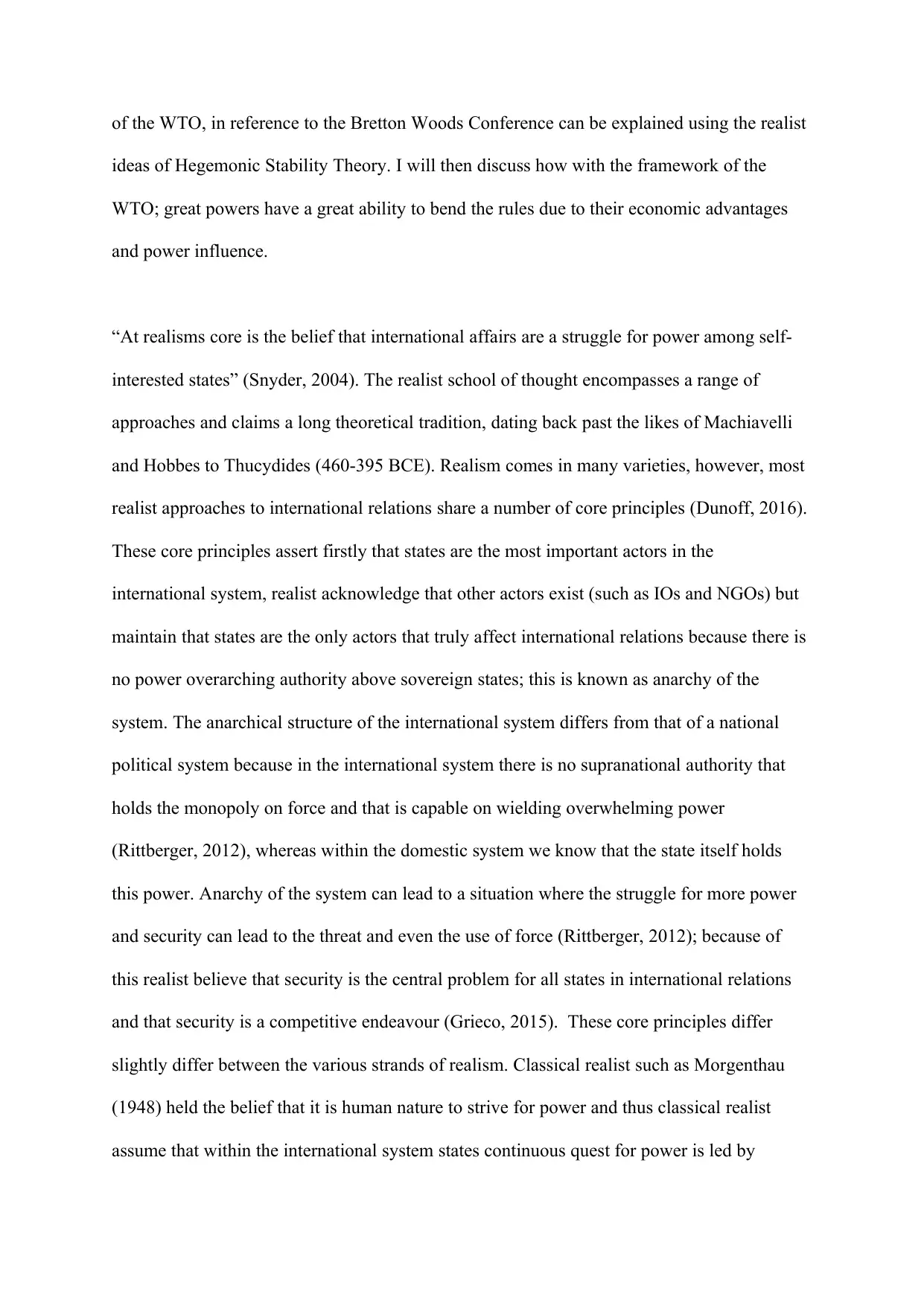
of the WTO, in reference to the Bretton Woods Conference can be explained using the realist
ideas of Hegemonic Stability Theory. I will then discuss how with the framework of the
WTO; great powers have a great ability to bend the rules due to their economic advantages
and power influence.
“At realisms core is the belief that international affairs are a struggle for power among self-
interested states” (Snyder, 2004). The realist school of thought encompasses a range of
approaches and claims a long theoretical tradition, dating back past the likes of Machiavelli
and Hobbes to Thucydides (460-395 BCE). Realism comes in many varieties, however, most
realist approaches to international relations share a number of core principles (Dunoff, 2016).
These core principles assert firstly that states are the most important actors in the
international system, realist acknowledge that other actors exist (such as IOs and NGOs) but
maintain that states are the only actors that truly affect international relations because there is
no power overarching authority above sovereign states; this is known as anarchy of the
system. The anarchical structure of the international system differs from that of a national
political system because in the international system there is no supranational authority that
holds the monopoly on force and that is capable on wielding overwhelming power
(Rittberger, 2012), whereas within the domestic system we know that the state itself holds
this power. Anarchy of the system can lead to a situation where the struggle for more power
and security can lead to the threat and even the use of force (Rittberger, 2012); because of
this realist believe that security is the central problem for all states in international relations
and that security is a competitive endeavour (Grieco, 2015). These core principles differ
slightly differ between the various strands of realism. Classical realist such as Morgenthau
(1948) held the belief that it is human nature to strive for power and thus classical realist
assume that within the international system states continuous quest for power is led by
ideas of Hegemonic Stability Theory. I will then discuss how with the framework of the
WTO; great powers have a great ability to bend the rules due to their economic advantages
and power influence.
“At realisms core is the belief that international affairs are a struggle for power among self-
interested states” (Snyder, 2004). The realist school of thought encompasses a range of
approaches and claims a long theoretical tradition, dating back past the likes of Machiavelli
and Hobbes to Thucydides (460-395 BCE). Realism comes in many varieties, however, most
realist approaches to international relations share a number of core principles (Dunoff, 2016).
These core principles assert firstly that states are the most important actors in the
international system, realist acknowledge that other actors exist (such as IOs and NGOs) but
maintain that states are the only actors that truly affect international relations because there is
no power overarching authority above sovereign states; this is known as anarchy of the
system. The anarchical structure of the international system differs from that of a national
political system because in the international system there is no supranational authority that
holds the monopoly on force and that is capable on wielding overwhelming power
(Rittberger, 2012), whereas within the domestic system we know that the state itself holds
this power. Anarchy of the system can lead to a situation where the struggle for more power
and security can lead to the threat and even the use of force (Rittberger, 2012); because of
this realist believe that security is the central problem for all states in international relations
and that security is a competitive endeavour (Grieco, 2015). These core principles differ
slightly differ between the various strands of realism. Classical realist such as Morgenthau
(1948) held the belief that it is human nature to strive for power and thus classical realist
assume that within the international system states continuous quest for power is led by

individual’s human nature (Rittberger, 2012). Neorealist, however, does not assume that it is
human nature that drives states to strive for power, but it is instead the “anarchical structure
of the international system which compels a state to pursue a predominantly security-oriented
policy of maximizing autonomy and influence by means of power” (Waltz, 1990 cited in
Rittberger, 2012). Now that I have discussed the overarching principles of realism, I will now
introduce some idea that will help to explain the functioning of IOs. Core realists such as
Waltz assert that the structure of IOs is a reflection of power distribution in the international
system and that IOs although generating outcomes that are Pareto improving they often still
are skewed towards powerful states (Dunoff, 2016). IOs tend to reflect the balance of power
that is seen in the international system for example IOs such as the UN and those who
institutions of the Bretton Woods Conference can be expected to “bare the imprint” of the
main hegemonic power in the international system which in this case is the United States
(Archer, 2014). Similarly, realist theory claims that IOs do little to help in the continuous
power struggle between states as they cannot change human nature or the anarchical system
that leads states to strive for more power (Rittberger, 2012). Instead, realists believe that IOs
are simply tools of powerful states to implement their own power politics and pursue self-
interest; the success of an IO according to realist is thus dependent on the existence of a great
power that possesses overwhelming power resources (Rittberger, 2012). Neo-realist Keohane
(1980, cited in Rittberger, 2012) believes that IOs can only contribute to international
cooperation if there is a hegemonic state that is willing to bear a large proportion of the
cooperation costs and thus binds other states into the organization using ‘carrots and sticks’.
The United Nations was promulgated on the 24th of October 1945 after being unanimously
adopted and signed by 51 member states; today 192 member states have now adopted the
charted and become members of the United Nations. The UN’s core aim is to ‘maintain
human nature that drives states to strive for power, but it is instead the “anarchical structure
of the international system which compels a state to pursue a predominantly security-oriented
policy of maximizing autonomy and influence by means of power” (Waltz, 1990 cited in
Rittberger, 2012). Now that I have discussed the overarching principles of realism, I will now
introduce some idea that will help to explain the functioning of IOs. Core realists such as
Waltz assert that the structure of IOs is a reflection of power distribution in the international
system and that IOs although generating outcomes that are Pareto improving they often still
are skewed towards powerful states (Dunoff, 2016). IOs tend to reflect the balance of power
that is seen in the international system for example IOs such as the UN and those who
institutions of the Bretton Woods Conference can be expected to “bare the imprint” of the
main hegemonic power in the international system which in this case is the United States
(Archer, 2014). Similarly, realist theory claims that IOs do little to help in the continuous
power struggle between states as they cannot change human nature or the anarchical system
that leads states to strive for more power (Rittberger, 2012). Instead, realists believe that IOs
are simply tools of powerful states to implement their own power politics and pursue self-
interest; the success of an IO according to realist is thus dependent on the existence of a great
power that possesses overwhelming power resources (Rittberger, 2012). Neo-realist Keohane
(1980, cited in Rittberger, 2012) believes that IOs can only contribute to international
cooperation if there is a hegemonic state that is willing to bear a large proportion of the
cooperation costs and thus binds other states into the organization using ‘carrots and sticks’.
The United Nations was promulgated on the 24th of October 1945 after being unanimously
adopted and signed by 51 member states; today 192 member states have now adopted the
charted and become members of the United Nations. The UN’s core aim is to ‘maintain
⊘ This is a preview!⊘
Do you want full access?
Subscribe today to unlock all pages.

Trusted by 1+ million students worldwide
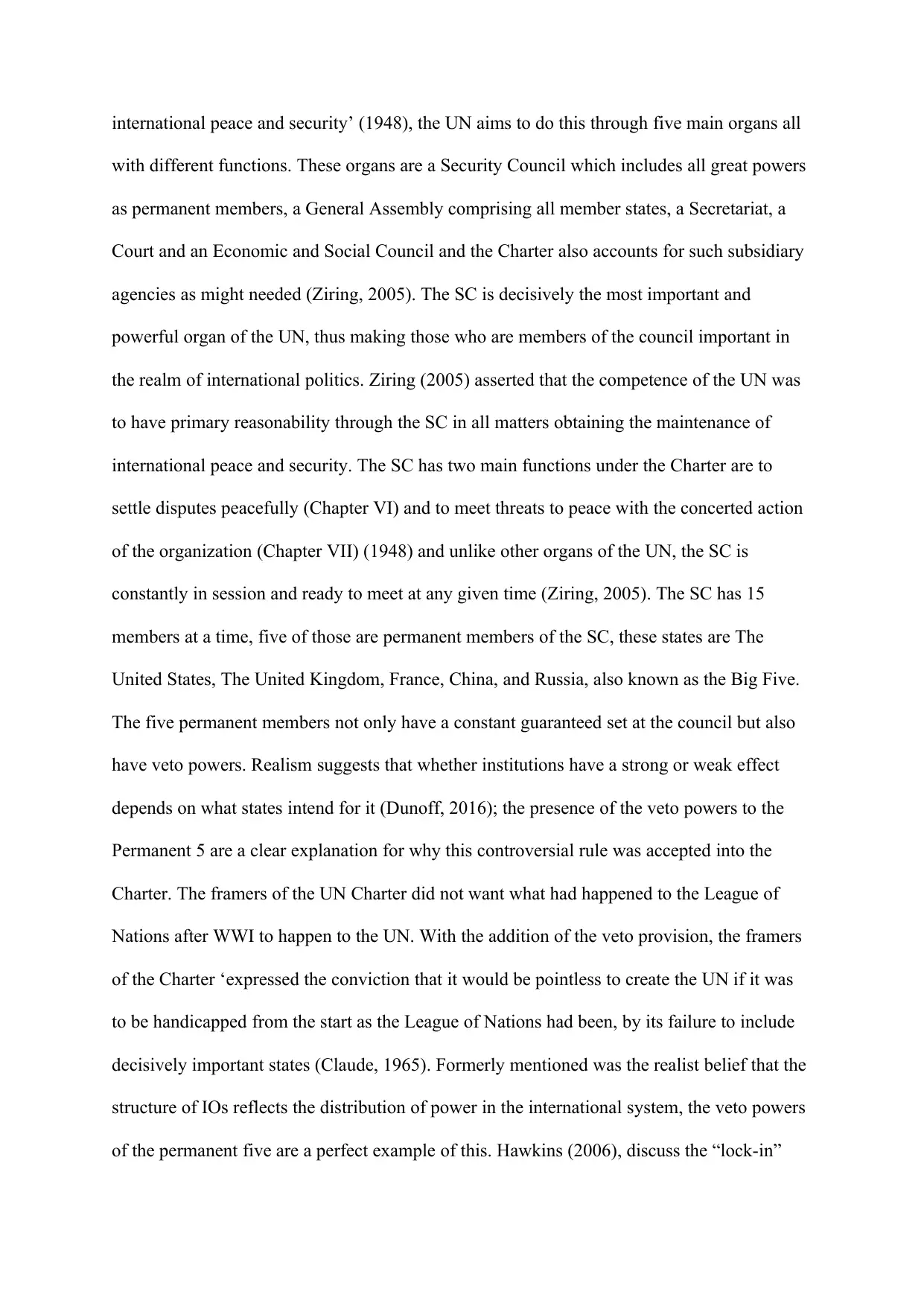
international peace and security’ (1948), the UN aims to do this through five main organs all
with different functions. These organs are a Security Council which includes all great powers
as permanent members, a General Assembly comprising all member states, a Secretariat, a
Court and an Economic and Social Council and the Charter also accounts for such subsidiary
agencies as might needed (Ziring, 2005). The SC is decisively the most important and
powerful organ of the UN, thus making those who are members of the council important in
the realm of international politics. Ziring (2005) asserted that the competence of the UN was
to have primary reasonability through the SC in all matters obtaining the maintenance of
international peace and security. The SC has two main functions under the Charter are to
settle disputes peacefully (Chapter VI) and to meet threats to peace with the concerted action
of the organization (Chapter VII) (1948) and unlike other organs of the UN, the SC is
constantly in session and ready to meet at any given time (Ziring, 2005). The SC has 15
members at a time, five of those are permanent members of the SC, these states are The
United States, The United Kingdom, France, China, and Russia, also known as the Big Five.
The five permanent members not only have a constant guaranteed set at the council but also
have veto powers. Realism suggests that whether institutions have a strong or weak effect
depends on what states intend for it (Dunoff, 2016); the presence of the veto powers to the
Permanent 5 are a clear explanation for why this controversial rule was accepted into the
Charter. The framers of the UN Charter did not want what had happened to the League of
Nations after WWI to happen to the UN. With the addition of the veto provision, the framers
of the Charter ‘expressed the conviction that it would be pointless to create the UN if it was
to be handicapped from the start as the League of Nations had been, by its failure to include
decisively important states (Claude, 1965). Formerly mentioned was the realist belief that the
structure of IOs reflects the distribution of power in the international system, the veto powers
of the permanent five are a perfect example of this. Hawkins (2006), discuss the “lock-in”
with different functions. These organs are a Security Council which includes all great powers
as permanent members, a General Assembly comprising all member states, a Secretariat, a
Court and an Economic and Social Council and the Charter also accounts for such subsidiary
agencies as might needed (Ziring, 2005). The SC is decisively the most important and
powerful organ of the UN, thus making those who are members of the council important in
the realm of international politics. Ziring (2005) asserted that the competence of the UN was
to have primary reasonability through the SC in all matters obtaining the maintenance of
international peace and security. The SC has two main functions under the Charter are to
settle disputes peacefully (Chapter VI) and to meet threats to peace with the concerted action
of the organization (Chapter VII) (1948) and unlike other organs of the UN, the SC is
constantly in session and ready to meet at any given time (Ziring, 2005). The SC has 15
members at a time, five of those are permanent members of the SC, these states are The
United States, The United Kingdom, France, China, and Russia, also known as the Big Five.
The five permanent members not only have a constant guaranteed set at the council but also
have veto powers. Realism suggests that whether institutions have a strong or weak effect
depends on what states intend for it (Dunoff, 2016); the presence of the veto powers to the
Permanent 5 are a clear explanation for why this controversial rule was accepted into the
Charter. The framers of the UN Charter did not want what had happened to the League of
Nations after WWI to happen to the UN. With the addition of the veto provision, the framers
of the Charter ‘expressed the conviction that it would be pointless to create the UN if it was
to be handicapped from the start as the League of Nations had been, by its failure to include
decisively important states (Claude, 1965). Formerly mentioned was the realist belief that the
structure of IOs reflects the distribution of power in the international system, the veto powers
of the permanent five are a perfect example of this. Hawkins (2006), discuss the “lock-in”
Paraphrase This Document
Need a fresh take? Get an instant paraphrase of this document with our AI Paraphraser
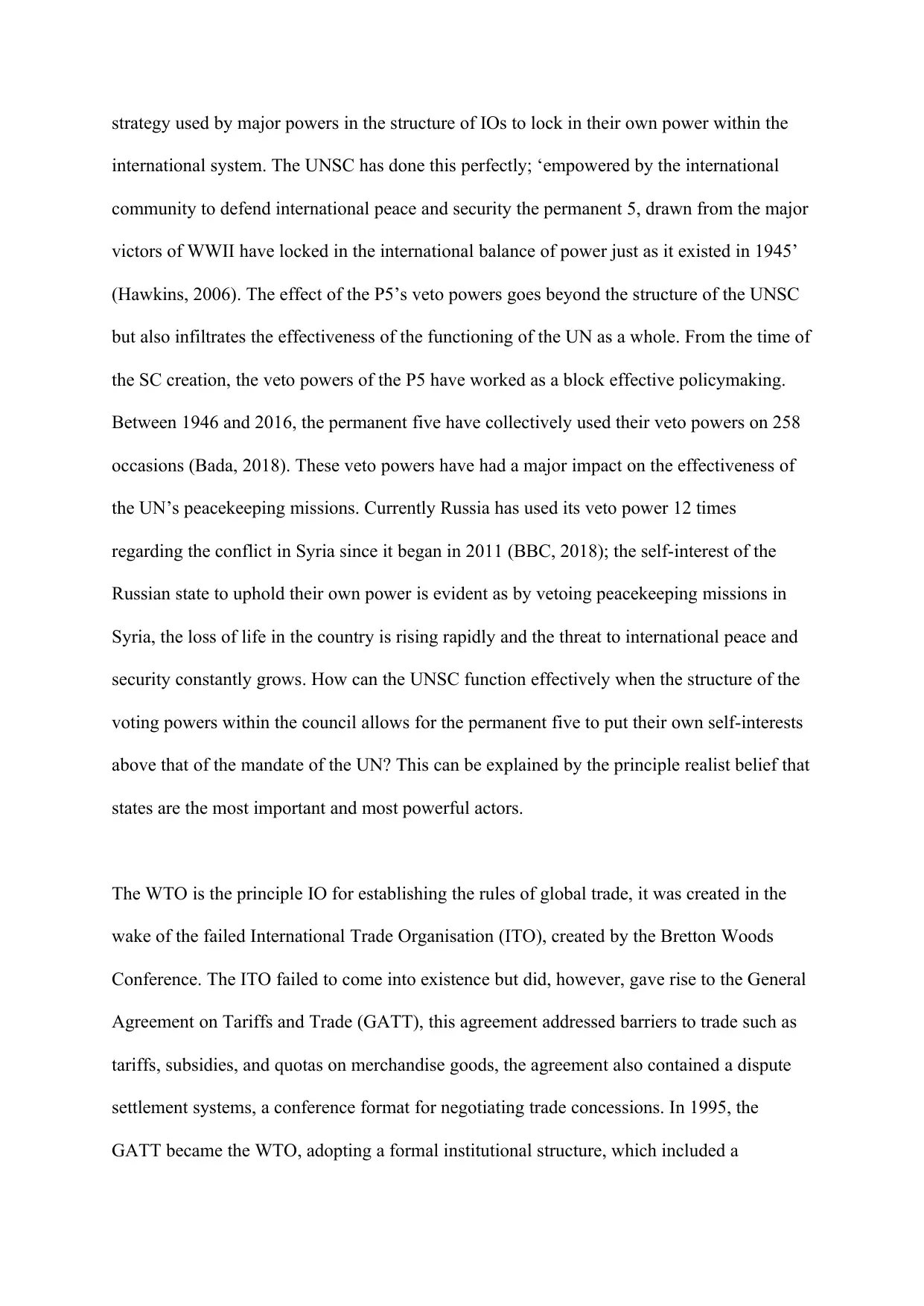
strategy used by major powers in the structure of IOs to lock in their own power within the
international system. The UNSC has done this perfectly; ‘empowered by the international
community to defend international peace and security the permanent 5, drawn from the major
victors of WWII have locked in the international balance of power just as it existed in 1945’
(Hawkins, 2006). The effect of the P5’s veto powers goes beyond the structure of the UNSC
but also infiltrates the effectiveness of the functioning of the UN as a whole. From the time of
the SC creation, the veto powers of the P5 have worked as a block effective policymaking.
Between 1946 and 2016, the permanent five have collectively used their veto powers on 258
occasions (Bada, 2018). These veto powers have had a major impact on the effectiveness of
the UN’s peacekeeping missions. Currently Russia has used its veto power 12 times
regarding the conflict in Syria since it began in 2011 (BBC, 2018); the self-interest of the
Russian state to uphold their own power is evident as by vetoing peacekeeping missions in
Syria, the loss of life in the country is rising rapidly and the threat to international peace and
security constantly grows. How can the UNSC function effectively when the structure of the
voting powers within the council allows for the permanent five to put their own self-interests
above that of the mandate of the UN? This can be explained by the principle realist belief that
states are the most important and most powerful actors.
The WTO is the principle IO for establishing the rules of global trade, it was created in the
wake of the failed International Trade Organisation (ITO), created by the Bretton Woods
Conference. The ITO failed to come into existence but did, however, gave rise to the General
Agreement on Tariffs and Trade (GATT), this agreement addressed barriers to trade such as
tariffs, subsidies, and quotas on merchandise goods, the agreement also contained a dispute
settlement systems, a conference format for negotiating trade concessions. In 1995, the
GATT became the WTO, adopting a formal institutional structure, which included a
international system. The UNSC has done this perfectly; ‘empowered by the international
community to defend international peace and security the permanent 5, drawn from the major
victors of WWII have locked in the international balance of power just as it existed in 1945’
(Hawkins, 2006). The effect of the P5’s veto powers goes beyond the structure of the UNSC
but also infiltrates the effectiveness of the functioning of the UN as a whole. From the time of
the SC creation, the veto powers of the P5 have worked as a block effective policymaking.
Between 1946 and 2016, the permanent five have collectively used their veto powers on 258
occasions (Bada, 2018). These veto powers have had a major impact on the effectiveness of
the UN’s peacekeeping missions. Currently Russia has used its veto power 12 times
regarding the conflict in Syria since it began in 2011 (BBC, 2018); the self-interest of the
Russian state to uphold their own power is evident as by vetoing peacekeeping missions in
Syria, the loss of life in the country is rising rapidly and the threat to international peace and
security constantly grows. How can the UNSC function effectively when the structure of the
voting powers within the council allows for the permanent five to put their own self-interests
above that of the mandate of the UN? This can be explained by the principle realist belief that
states are the most important and most powerful actors.
The WTO is the principle IO for establishing the rules of global trade, it was created in the
wake of the failed International Trade Organisation (ITO), created by the Bretton Woods
Conference. The ITO failed to come into existence but did, however, gave rise to the General
Agreement on Tariffs and Trade (GATT), this agreement addressed barriers to trade such as
tariffs, subsidies, and quotas on merchandise goods, the agreement also contained a dispute
settlement systems, a conference format for negotiating trade concessions. In 1995, the
GATT became the WTO, adopting a formal institutional structure, which included a
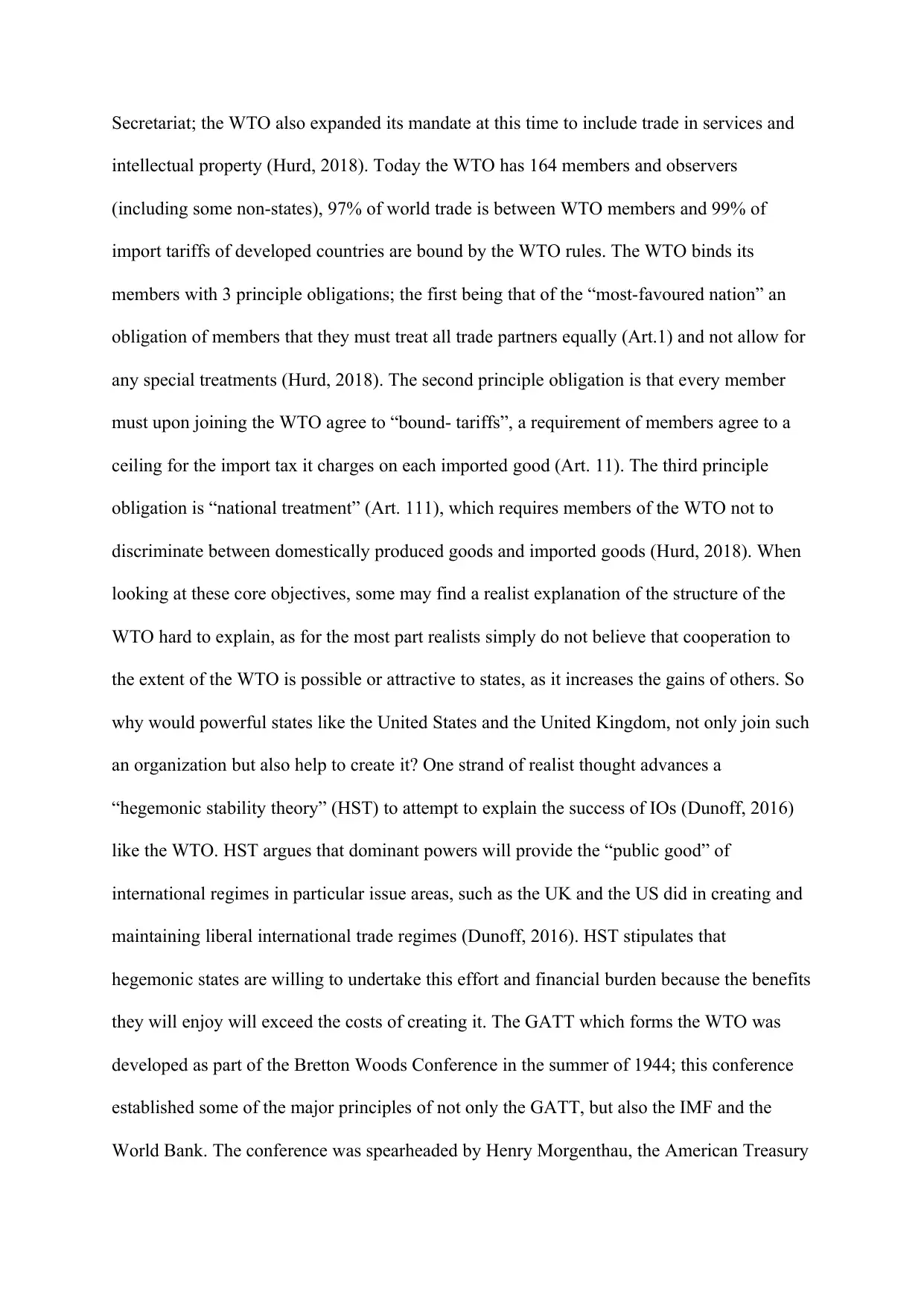
Secretariat; the WTO also expanded its mandate at this time to include trade in services and
intellectual property (Hurd, 2018). Today the WTO has 164 members and observers
(including some non-states), 97% of world trade is between WTO members and 99% of
import tariffs of developed countries are bound by the WTO rules. The WTO binds its
members with 3 principle obligations; the first being that of the “most-favoured nation” an
obligation of members that they must treat all trade partners equally (Art.1) and not allow for
any special treatments (Hurd, 2018). The second principle obligation is that every member
must upon joining the WTO agree to “bound- tariffs”, a requirement of members agree to a
ceiling for the import tax it charges on each imported good (Art. 11). The third principle
obligation is “national treatment” (Art. 111), which requires members of the WTO not to
discriminate between domestically produced goods and imported goods (Hurd, 2018). When
looking at these core objectives, some may find a realist explanation of the structure of the
WTO hard to explain, as for the most part realists simply do not believe that cooperation to
the extent of the WTO is possible or attractive to states, as it increases the gains of others. So
why would powerful states like the United States and the United Kingdom, not only join such
an organization but also help to create it? One strand of realist thought advances a
“hegemonic stability theory” (HST) to attempt to explain the success of IOs (Dunoff, 2016)
like the WTO. HST argues that dominant powers will provide the “public good” of
international regimes in particular issue areas, such as the UK and the US did in creating and
maintaining liberal international trade regimes (Dunoff, 2016). HST stipulates that
hegemonic states are willing to undertake this effort and financial burden because the benefits
they will enjoy will exceed the costs of creating it. The GATT which forms the WTO was
developed as part of the Bretton Woods Conference in the summer of 1944; this conference
established some of the major principles of not only the GATT, but also the IMF and the
World Bank. The conference was spearheaded by Henry Morgenthau, the American Treasury
intellectual property (Hurd, 2018). Today the WTO has 164 members and observers
(including some non-states), 97% of world trade is between WTO members and 99% of
import tariffs of developed countries are bound by the WTO rules. The WTO binds its
members with 3 principle obligations; the first being that of the “most-favoured nation” an
obligation of members that they must treat all trade partners equally (Art.1) and not allow for
any special treatments (Hurd, 2018). The second principle obligation is that every member
must upon joining the WTO agree to “bound- tariffs”, a requirement of members agree to a
ceiling for the import tax it charges on each imported good (Art. 11). The third principle
obligation is “national treatment” (Art. 111), which requires members of the WTO not to
discriminate between domestically produced goods and imported goods (Hurd, 2018). When
looking at these core objectives, some may find a realist explanation of the structure of the
WTO hard to explain, as for the most part realists simply do not believe that cooperation to
the extent of the WTO is possible or attractive to states, as it increases the gains of others. So
why would powerful states like the United States and the United Kingdom, not only join such
an organization but also help to create it? One strand of realist thought advances a
“hegemonic stability theory” (HST) to attempt to explain the success of IOs (Dunoff, 2016)
like the WTO. HST argues that dominant powers will provide the “public good” of
international regimes in particular issue areas, such as the UK and the US did in creating and
maintaining liberal international trade regimes (Dunoff, 2016). HST stipulates that
hegemonic states are willing to undertake this effort and financial burden because the benefits
they will enjoy will exceed the costs of creating it. The GATT which forms the WTO was
developed as part of the Bretton Woods Conference in the summer of 1944; this conference
established some of the major principles of not only the GATT, but also the IMF and the
World Bank. The conference was spearheaded by Henry Morgenthau, the American Treasury
⊘ This is a preview!⊘
Do you want full access?
Subscribe today to unlock all pages.

Trusted by 1+ million students worldwide
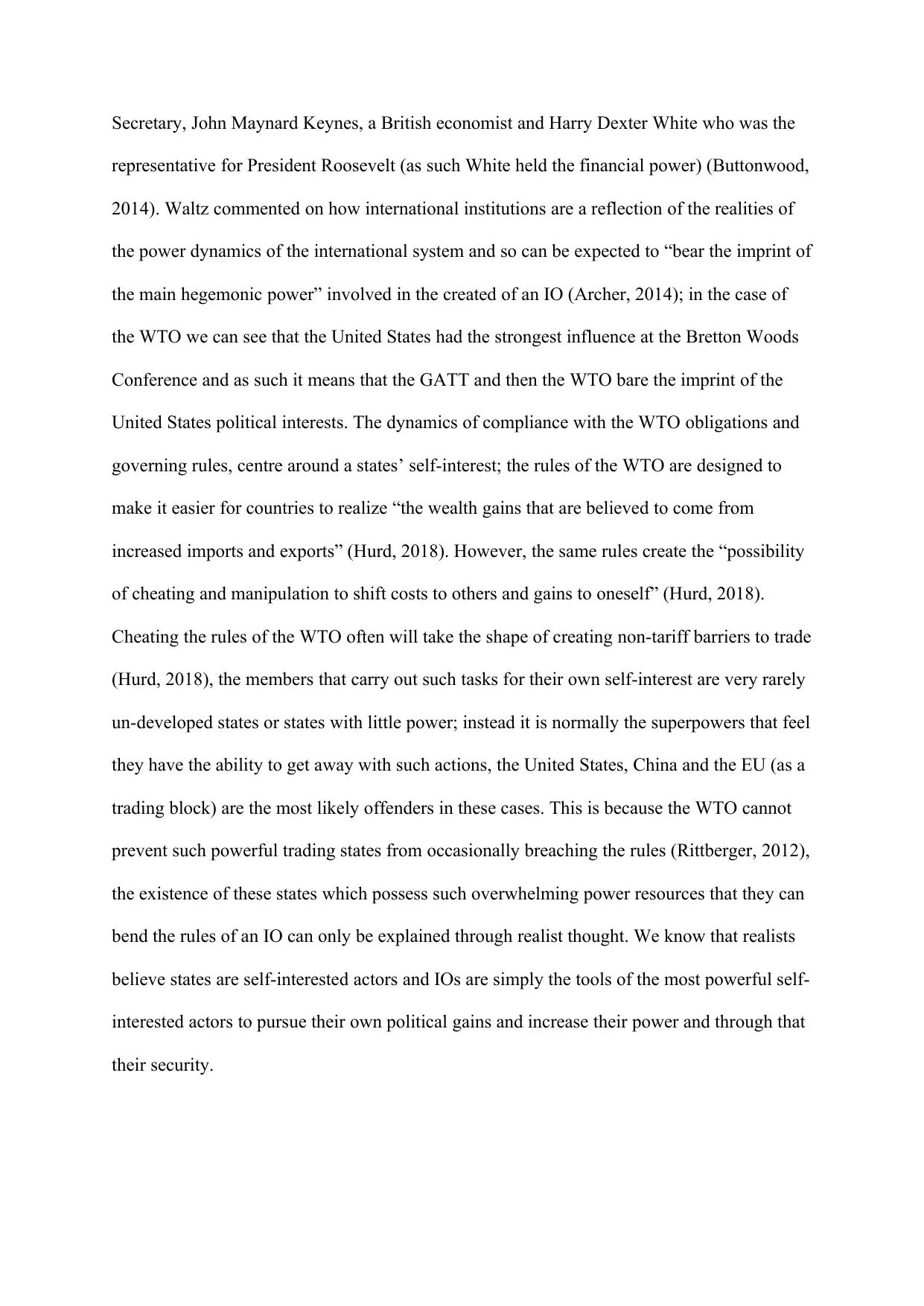
Secretary, John Maynard Keynes, a British economist and Harry Dexter White who was the
representative for President Roosevelt (as such White held the financial power) (Buttonwood,
2014). Waltz commented on how international institutions are a reflection of the realities of
the power dynamics of the international system and so can be expected to “bear the imprint of
the main hegemonic power” involved in the created of an IO (Archer, 2014); in the case of
the WTO we can see that the United States had the strongest influence at the Bretton Woods
Conference and as such it means that the GATT and then the WTO bare the imprint of the
United States political interests. The dynamics of compliance with the WTO obligations and
governing rules, centre around a states’ self-interest; the rules of the WTO are designed to
make it easier for countries to realize “the wealth gains that are believed to come from
increased imports and exports” (Hurd, 2018). However, the same rules create the “possibility
of cheating and manipulation to shift costs to others and gains to oneself” (Hurd, 2018).
Cheating the rules of the WTO often will take the shape of creating non-tariff barriers to trade
(Hurd, 2018), the members that carry out such tasks for their own self-interest are very rarely
un-developed states or states with little power; instead it is normally the superpowers that feel
they have the ability to get away with such actions, the United States, China and the EU (as a
trading block) are the most likely offenders in these cases. This is because the WTO cannot
prevent such powerful trading states from occasionally breaching the rules (Rittberger, 2012),
the existence of these states which possess such overwhelming power resources that they can
bend the rules of an IO can only be explained through realist thought. We know that realists
believe states are self-interested actors and IOs are simply the tools of the most powerful self-
interested actors to pursue their own political gains and increase their power and through that
their security.
representative for President Roosevelt (as such White held the financial power) (Buttonwood,
2014). Waltz commented on how international institutions are a reflection of the realities of
the power dynamics of the international system and so can be expected to “bear the imprint of
the main hegemonic power” involved in the created of an IO (Archer, 2014); in the case of
the WTO we can see that the United States had the strongest influence at the Bretton Woods
Conference and as such it means that the GATT and then the WTO bare the imprint of the
United States political interests. The dynamics of compliance with the WTO obligations and
governing rules, centre around a states’ self-interest; the rules of the WTO are designed to
make it easier for countries to realize “the wealth gains that are believed to come from
increased imports and exports” (Hurd, 2018). However, the same rules create the “possibility
of cheating and manipulation to shift costs to others and gains to oneself” (Hurd, 2018).
Cheating the rules of the WTO often will take the shape of creating non-tariff barriers to trade
(Hurd, 2018), the members that carry out such tasks for their own self-interest are very rarely
un-developed states or states with little power; instead it is normally the superpowers that feel
they have the ability to get away with such actions, the United States, China and the EU (as a
trading block) are the most likely offenders in these cases. This is because the WTO cannot
prevent such powerful trading states from occasionally breaching the rules (Rittberger, 2012),
the existence of these states which possess such overwhelming power resources that they can
bend the rules of an IO can only be explained through realist thought. We know that realists
believe states are self-interested actors and IOs are simply the tools of the most powerful self-
interested actors to pursue their own political gains and increase their power and through that
their security.
Paraphrase This Document
Need a fresh take? Get an instant paraphrase of this document with our AI Paraphraser
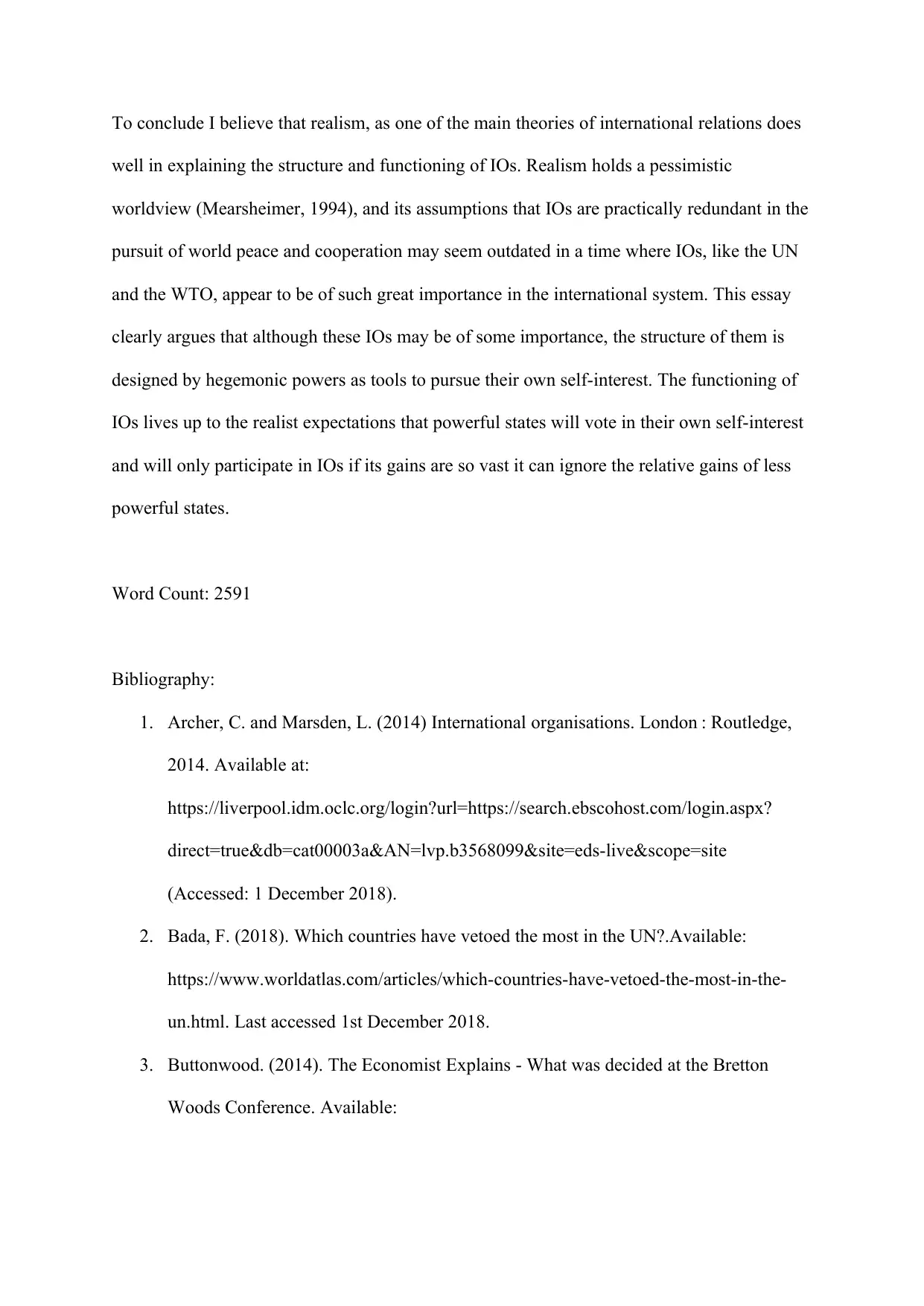
To conclude I believe that realism, as one of the main theories of international relations does
well in explaining the structure and functioning of IOs. Realism holds a pessimistic
worldview (Mearsheimer, 1994), and its assumptions that IOs are practically redundant in the
pursuit of world peace and cooperation may seem outdated in a time where IOs, like the UN
and the WTO, appear to be of such great importance in the international system. This essay
clearly argues that although these IOs may be of some importance, the structure of them is
designed by hegemonic powers as tools to pursue their own self-interest. The functioning of
IOs lives up to the realist expectations that powerful states will vote in their own self-interest
and will only participate in IOs if its gains are so vast it can ignore the relative gains of less
powerful states.
Word Count: 2591
Bibliography:
1. Archer, C. and Marsden, L. (2014) International organisations. London : Routledge,
2014. Available at:
https://liverpool.idm.oclc.org/login?url=https://search.ebscohost.com/login.aspx?
direct=true&db=cat00003a&AN=lvp.b3568099&site=eds-live&scope=site
(Accessed: 1 December 2018).
2. Bada, F. (2018). Which countries have vetoed the most in the UN?.Available:
https://www.worldatlas.com/articles/which-countries-have-vetoed-the-most-in-the-
un.html. Last accessed 1st December 2018.
3. Buttonwood. (2014). The Economist Explains - What was decided at the Bretton
Woods Conference. Available:
well in explaining the structure and functioning of IOs. Realism holds a pessimistic
worldview (Mearsheimer, 1994), and its assumptions that IOs are practically redundant in the
pursuit of world peace and cooperation may seem outdated in a time where IOs, like the UN
and the WTO, appear to be of such great importance in the international system. This essay
clearly argues that although these IOs may be of some importance, the structure of them is
designed by hegemonic powers as tools to pursue their own self-interest. The functioning of
IOs lives up to the realist expectations that powerful states will vote in their own self-interest
and will only participate in IOs if its gains are so vast it can ignore the relative gains of less
powerful states.
Word Count: 2591
Bibliography:
1. Archer, C. and Marsden, L. (2014) International organisations. London : Routledge,
2014. Available at:
https://liverpool.idm.oclc.org/login?url=https://search.ebscohost.com/login.aspx?
direct=true&db=cat00003a&AN=lvp.b3568099&site=eds-live&scope=site
(Accessed: 1 December 2018).
2. Bada, F. (2018). Which countries have vetoed the most in the UN?.Available:
https://www.worldatlas.com/articles/which-countries-have-vetoed-the-most-in-the-
un.html. Last accessed 1st December 2018.
3. Buttonwood. (2014). The Economist Explains - What was decided at the Bretton
Woods Conference. Available:
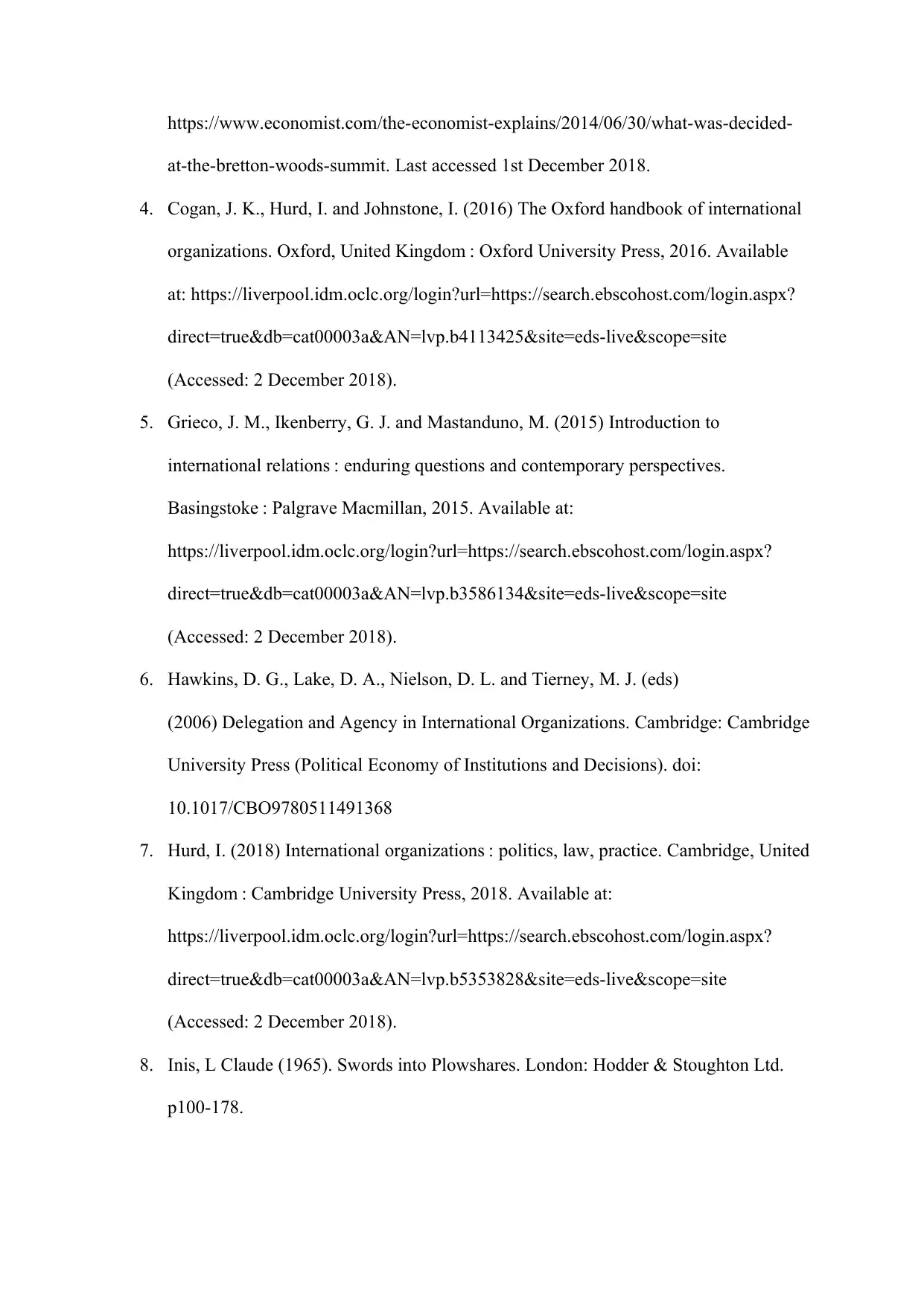
https://www.economist.com/the-economist-explains/2014/06/30/what-was-decided-
at-the-bretton-woods-summit. Last accessed 1st December 2018.
4. Cogan, J. K., Hurd, I. and Johnstone, I. (2016) The Oxford handbook of international
organizations. Oxford, United Kingdom : Oxford University Press, 2016. Available
at: https://liverpool.idm.oclc.org/login?url=https://search.ebscohost.com/login.aspx?
direct=true&db=cat00003a&AN=lvp.b4113425&site=eds-live&scope=site
(Accessed: 2 December 2018).
5. Grieco, J. M., Ikenberry, G. J. and Mastanduno, M. (2015) Introduction to
international relations : enduring questions and contemporary perspectives.
Basingstoke : Palgrave Macmillan, 2015. Available at:
https://liverpool.idm.oclc.org/login?url=https://search.ebscohost.com/login.aspx?
direct=true&db=cat00003a&AN=lvp.b3586134&site=eds-live&scope=site
(Accessed: 2 December 2018).
6. Hawkins, D. G., Lake, D. A., Nielson, D. L. and Tierney, M. J. (eds)
(2006) Delegation and Agency in International Organizations. Cambridge: Cambridge
University Press (Political Economy of Institutions and Decisions). doi:
10.1017/CBO9780511491368
7. Hurd, I. (2018) International organizations : politics, law, practice. Cambridge, United
Kingdom : Cambridge University Press, 2018. Available at:
https://liverpool.idm.oclc.org/login?url=https://search.ebscohost.com/login.aspx?
direct=true&db=cat00003a&AN=lvp.b5353828&site=eds-live&scope=site
(Accessed: 2 December 2018).
8. Inis, L Claude (1965). Swords into Plowshares. London: Hodder & Stoughton Ltd.
p100-178.
at-the-bretton-woods-summit. Last accessed 1st December 2018.
4. Cogan, J. K., Hurd, I. and Johnstone, I. (2016) The Oxford handbook of international
organizations. Oxford, United Kingdom : Oxford University Press, 2016. Available
at: https://liverpool.idm.oclc.org/login?url=https://search.ebscohost.com/login.aspx?
direct=true&db=cat00003a&AN=lvp.b4113425&site=eds-live&scope=site
(Accessed: 2 December 2018).
5. Grieco, J. M., Ikenberry, G. J. and Mastanduno, M. (2015) Introduction to
international relations : enduring questions and contemporary perspectives.
Basingstoke : Palgrave Macmillan, 2015. Available at:
https://liverpool.idm.oclc.org/login?url=https://search.ebscohost.com/login.aspx?
direct=true&db=cat00003a&AN=lvp.b3586134&site=eds-live&scope=site
(Accessed: 2 December 2018).
6. Hawkins, D. G., Lake, D. A., Nielson, D. L. and Tierney, M. J. (eds)
(2006) Delegation and Agency in International Organizations. Cambridge: Cambridge
University Press (Political Economy of Institutions and Decisions). doi:
10.1017/CBO9780511491368
7. Hurd, I. (2018) International organizations : politics, law, practice. Cambridge, United
Kingdom : Cambridge University Press, 2018. Available at:
https://liverpool.idm.oclc.org/login?url=https://search.ebscohost.com/login.aspx?
direct=true&db=cat00003a&AN=lvp.b5353828&site=eds-live&scope=site
(Accessed: 2 December 2018).
8. Inis, L Claude (1965). Swords into Plowshares. London: Hodder & Stoughton Ltd.
p100-178.
⊘ This is a preview!⊘
Do you want full access?
Subscribe today to unlock all pages.

Trusted by 1+ million students worldwide
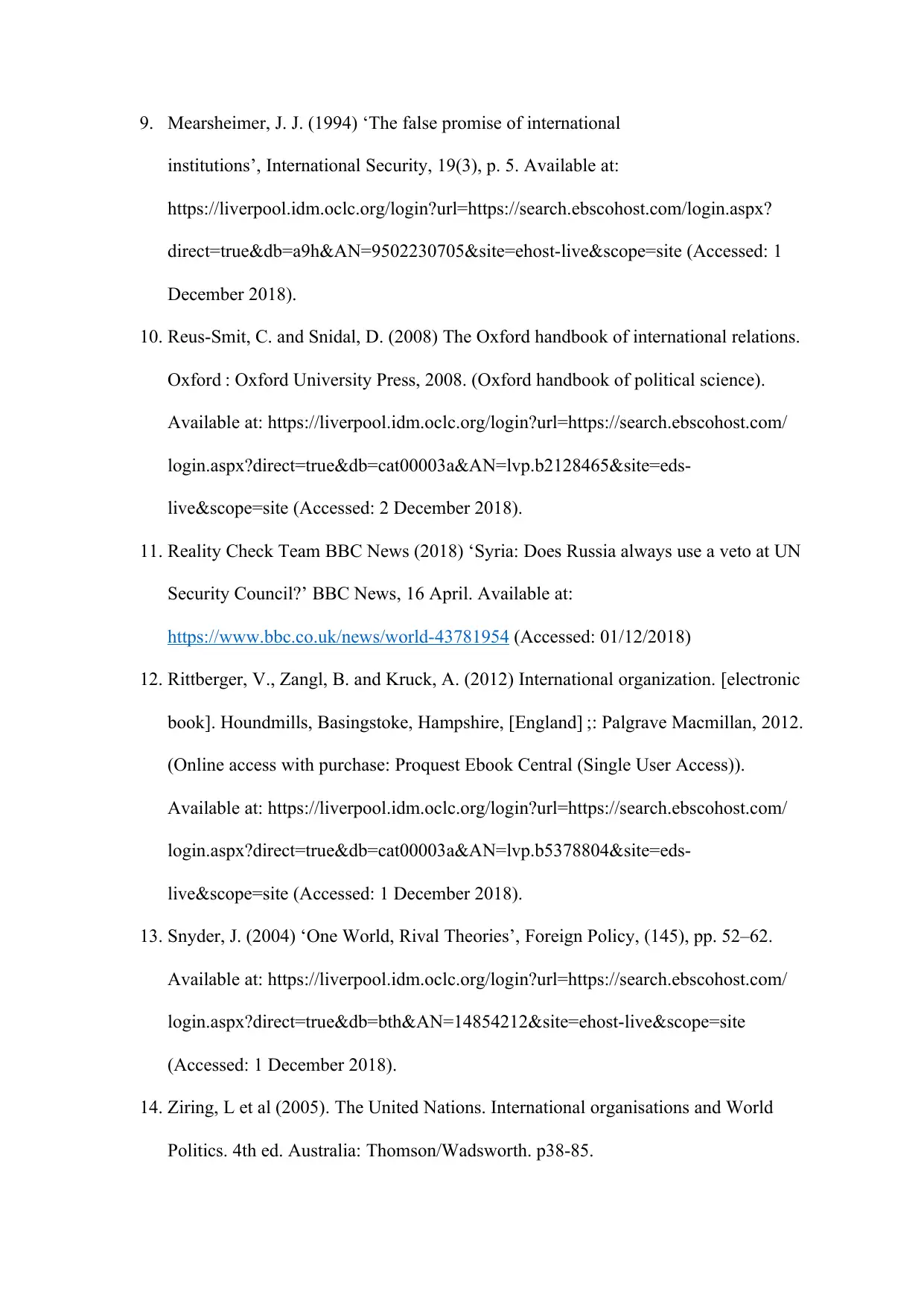
9. Mearsheimer, J. J. (1994) ‘The false promise of international
institutions’, International Security, 19(3), p. 5. Available at:
https://liverpool.idm.oclc.org/login?url=https://search.ebscohost.com/login.aspx?
direct=true&db=a9h&AN=9502230705&site=ehost-live&scope=site (Accessed: 1
December 2018).
10. Reus-Smit, C. and Snidal, D. (2008) The Oxford handbook of international relations.
Oxford : Oxford University Press, 2008. (Oxford handbook of political science).
Available at: https://liverpool.idm.oclc.org/login?url=https://search.ebscohost.com/
login.aspx?direct=true&db=cat00003a&AN=lvp.b2128465&site=eds-
live&scope=site (Accessed: 2 December 2018).
11. Reality Check Team BBC News (2018) ‘Syria: Does Russia always use a veto at UN
Security Council?’ BBC News, 16 April. Available at:
https://www.bbc.co.uk/news/world-43781954 (Accessed: 01/12/2018)
12. Rittberger, V., Zangl, B. and Kruck, A. (2012) International organization. [electronic
book]. Houndmills, Basingstoke, Hampshire, [England] ;: Palgrave Macmillan, 2012.
(Online access with purchase: Proquest Ebook Central (Single User Access)).
Available at: https://liverpool.idm.oclc.org/login?url=https://search.ebscohost.com/
login.aspx?direct=true&db=cat00003a&AN=lvp.b5378804&site=eds-
live&scope=site (Accessed: 1 December 2018).
13. Snyder, J. (2004) ‘One World, Rival Theories’, Foreign Policy, (145), pp. 52–62.
Available at: https://liverpool.idm.oclc.org/login?url=https://search.ebscohost.com/
login.aspx?direct=true&db=bth&AN=14854212&site=ehost-live&scope=site
(Accessed: 1 December 2018).
14. Ziring, L et al (2005). The United Nations. International organisations and World
Politics. 4th ed. Australia: Thomson/Wadsworth. p38-85.
institutions’, International Security, 19(3), p. 5. Available at:
https://liverpool.idm.oclc.org/login?url=https://search.ebscohost.com/login.aspx?
direct=true&db=a9h&AN=9502230705&site=ehost-live&scope=site (Accessed: 1
December 2018).
10. Reus-Smit, C. and Snidal, D. (2008) The Oxford handbook of international relations.
Oxford : Oxford University Press, 2008. (Oxford handbook of political science).
Available at: https://liverpool.idm.oclc.org/login?url=https://search.ebscohost.com/
login.aspx?direct=true&db=cat00003a&AN=lvp.b2128465&site=eds-
live&scope=site (Accessed: 2 December 2018).
11. Reality Check Team BBC News (2018) ‘Syria: Does Russia always use a veto at UN
Security Council?’ BBC News, 16 April. Available at:
https://www.bbc.co.uk/news/world-43781954 (Accessed: 01/12/2018)
12. Rittberger, V., Zangl, B. and Kruck, A. (2012) International organization. [electronic
book]. Houndmills, Basingstoke, Hampshire, [England] ;: Palgrave Macmillan, 2012.
(Online access with purchase: Proquest Ebook Central (Single User Access)).
Available at: https://liverpool.idm.oclc.org/login?url=https://search.ebscohost.com/
login.aspx?direct=true&db=cat00003a&AN=lvp.b5378804&site=eds-
live&scope=site (Accessed: 1 December 2018).
13. Snyder, J. (2004) ‘One World, Rival Theories’, Foreign Policy, (145), pp. 52–62.
Available at: https://liverpool.idm.oclc.org/login?url=https://search.ebscohost.com/
login.aspx?direct=true&db=bth&AN=14854212&site=ehost-live&scope=site
(Accessed: 1 December 2018).
14. Ziring, L et al (2005). The United Nations. International organisations and World
Politics. 4th ed. Australia: Thomson/Wadsworth. p38-85.
Paraphrase This Document
Need a fresh take? Get an instant paraphrase of this document with our AI Paraphraser

1 out of 11
Related Documents
Your All-in-One AI-Powered Toolkit for Academic Success.
+13062052269
info@desklib.com
Available 24*7 on WhatsApp / Email
![[object Object]](/_next/static/media/star-bottom.7253800d.svg)
Unlock your academic potential
Copyright © 2020–2025 A2Z Services. All Rights Reserved. Developed and managed by ZUCOL.



